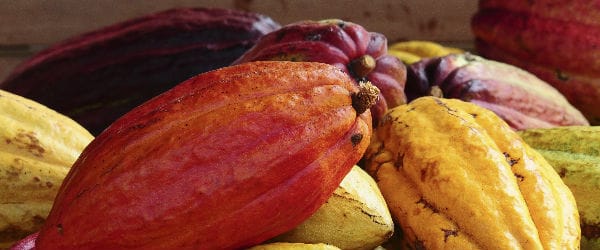
We love chocolate, but what do we know of its path from the rainforest to the giftbox? As it turns out, the journey to the delight we all know and love are deeply rooted in history, nature, and involve time-honored traditions.
Cacao, or Theobroma cacao, is a tropical evergreen tree that grows in Central America, South America, the Caribbean, and Africa. The brown seeds (or beans) grow inside large green pods that turn yellow, red, or purple when ripe. It is thought that cacao was first cultivated in the Amazon River basin, but the exact origin is unknown. It is known, however, that the Olmec, Mayas, and Aztecs used the cacao beans long before it reached Europe.
Theobroma means “food of the gods”, which is very fitting for a plant that was used by the Maya in religious rituals and thought of by the Aztecs as a gift from their god, Quetzalcoatl. Both cultures drank “xocolatl,” a bitter and spicy drink that was thought to give wisdom and power, nourishment and strength. The Aztec king Montezuma is thought to have drunk up to 50 goblets of it a day. He thought it was more valuable than the golden goblets from which he drank, so he would throw the goblets away after just one use. In fact, cacao beans were so valuable that they were used as currency during the Aztec reign.
Today, cacao has a strong place in the modern world. From cacao comes cacao powder, cocoa powder, and our beloved chocolate. Cacao powder is created by removing the fat (the cacao butter) from dried cacao beans and grinding them; it is chocolate in its purest form. Cocoa powder is prepared similarly to cacao powder, but in production it is exposed to high levels of heat. Chocolate, on the other hand, is made by grinding the dried beans while retaining the fat, then adding sweeteners and/or milk.
Cacao, and therefore cocoa and chocolate, has many health benefits. It is a powerful antioxidant (it has more antioxidant power than black tea and red wine); is rich in magnesium; and has a positive effect on the cardiovascular system, cholesterol, and blood flow. In addition to these health benefits, cacao is literally a pleasure to eat. It contains the neurotransmitter phenylethylamine (PEA) that acts on the pleasure centers of the brain. PEA induces feelings of euphoria, excitement, and attraction, so it is no wonder people crave and reach for chocolate when they need a little treat.
It is important to note that because chocolate is in high demand worldwide, it is necessary to grow and harvest cacao sustainably. Cacao grows best under the shade of other trees; it thrives in tropical areas that have high levels of humidity and a lot of rain. Because Cacao trees need this kind of environment, rainforests do not need to be cut down in order to grow them. There are organizations, such as the Rainforest Alliance, who are working with farmers to grow cacao more sustainably, which in turn is helping the farmers harvest a better product that will earn them more money when they bring it to market. As this practice spreads, we will continue to be able to enjoy this delicious, healthful food long into the future while still inhabiting this beautiful planet.
Want to learn more? Here is what we read:
Websites:
Botanical.com
Godiva
One Green Planet
Rainforest Alliance
Raintree: Tropical Plant Database
Books: The Encyclopedia of Healing Foods by Michael Murray, and Joseph Pizzorno, with Laura Pizzorno. 2005. Atria Books. New York, NY